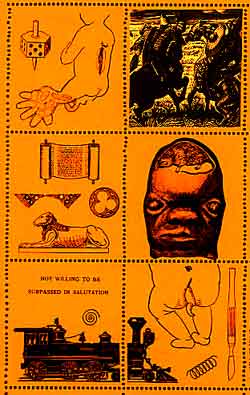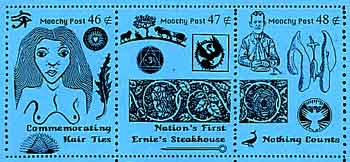
Gummed Papers for Cinderella Stamps
A mail artist of long standing wrote to me asking how to get gummed paper with which to make "cinderellas" aka aristamps. It quite surprised me that someone who has already been making lovely stamps might not know this, but then, many artistamps in fact have no gum to them but must be pasted if one wishes to use them. So here's the dope on gummed papers:
There are two types of paper commonly used: DRYGUM PAPER & PRESSURE-GUM PAPER. The former is preferable, so ask your paper supplier for DryGum paper. This is lick-&-stick. DryGums can be purchased by the ream in a variety of colors, & it's relatively cheap, though not real cheap. A ream is 500 sheets, which can last an awfully long time. I get mine from Arvey Paper or the Paper Zone, but every city has its own big paper suppliers, where drygums will be more regularly stocked & cheaper than if bought in a university bookstore or at a stationers.
 If you live far from a major paper supply house, you may have to special order it through an office supply, printing supply, or stationary store, where they might charge more since it's not the sort of paper all places carry automatically. Your supplier may look at you funny & claim they never heard of DryGum paper, but if you force them to look in their wholesalers' paper catalogs, it will be listed as DryGum.
If you live far from a major paper supply house, you may have to special order it through an office supply, printing supply, or stationary store, where they might charge more since it's not the sort of paper all places carry automatically. Your supplier may look at you funny & claim they never heard of DryGum paper, but if you force them to look in their wholesalers' paper catalogs, it will be listed as DryGum.Most (but not all) DryGums as manufactured today are pH-neutral (commonly called "acid free"). The paper itself by current manufacturing methods have done away from acidic bonding agents even for cheap pulp & newsprint. The chemicals in the drygum fixative are not invariably neutral-pH, but archival DryGum paper is available. Up to about twenty years ago, all DryGums tended over time to yellow whatever they came in contact with, & to brown at the edges of each sheet within a very short time (five or six years). But today's better DryGums possess nearly inert qualities. They may still react to vintage papers which are apt to have been manufactured with acidic bonding agents or have high lignen content so that they brown over time, & there's also the problem that some (but not all) photocopying systems put the sheets through a faint chemical bath that acidifies the paper. But with a quality DryGum, an artist is at least starting from a position of archival features, & can consider steps to keep the paper from becoming environmentally acidified.
 Neutral pH papers were formerly a somewhat specialized product, but nowadays are standard. So when you start with DryGum, you're starting with something that is nearly or wholy of ARCHIVAL QUALITY. If you use inks such as are available for linocut or block print making, sumi-e or India ink, lithographic of offset inks, or quality artists' paints, these too are usually archival, & you'll be making tiny permanent artworks.
Neutral pH papers were formerly a somewhat specialized product, but nowadays are standard. So when you start with DryGum, you're starting with something that is nearly or wholy of ARCHIVAL QUALITY. If you use inks such as are available for linocut or block print making, sumi-e or India ink, lithographic of offset inks, or quality artists' paints, these too are usually archival, & you'll be making tiny permanent artworks.If however you use standard rubber stamp-pad inks, felt pens, color computer printer pens, or certain artist pen inks & watercolors, these are NON-ARCHIVAL & extremely fragile, sometimes vanishing entirely when exposed to sunlight, other times changing the acidic properties of the paper they are used on. (As an aside, you can re-ink rubber stamp pads with permanent inks, but it will have to be a conscious choice.) Some pigments that are mixed with water recommend being used with distilled water, because tapwater usually adds iron & other impurities that will negate the archival quality of the medium.
Pressure-gums are another matter. Paper manufacturers have not yet come up with a peel-&-stick pressure-gum paper that is archival. The property of remaining tacky to the touch for a long period of time seems to be at odds with acid-neutrality. Manufacturers are striving toward an archival pressure-gum in great part because of Uncle Sam's & the philatelic community's needs. Stamp collectors have had to devise difficult methods of removing the gum from peel-&am-stick postage stamps; collectors cannot expect to preserve the increasing numbers of pressure-gum postage stamps in as-issued mint condition for future posterity. To achieve permanency, these stamps have to be soaked for days in a volatile agent, then the pressure-gum "balled" with the finger to remove it, after which the stamp (itself printed on acid-neutral paper) can be preserved into perpetuity. But many stamp collectors have already been discouraged to find their pressure-gum stamps, preserved intact, have after a decade or two shown signs of decay. The once-tacky gum sometimes hardens & lets go of the removable backing. Fewer pressure-gums soften with age & loose their tackiness or even "bleed" out from under their backings. Or the pressure-gum interacts destructively with the paper of the stamp resulting in spotty marks on the printed face. Or it interacts with the albums the intact pressure-gum stamps are mounted in.
The problem of pressure-gum being non-archival may or may not eventually be overcome someday. To date no pressure-gum has passed the archival test & anyone trying to preserve such papers long-term will have to separate them with buffering paper to extend the limited lifespan. Protective papers with buffering agents built in help preserve non-archival paper, but the buffered papers themselves become acidified with time when in contact with nonarchival papers, so have to be replaced every few years. (Buffering papers are sometimes available from comic book stores as they are used to keep vintage comcs from brittling, but you may have to contact a specialized library or archival supply house.)
In all, if you use pressure-gum papers, expect your creations to deteriorate over time. DryGum is far superior if you want your stamps to have lasting power as treasurable mini-art.
However, because mail art tends toward the ephemeral, there's nothing wrong with making stamps out of anything you can get your hands on, whether or not it results in an archivally sound cinderella. Well, the type of artistamper who is trying to sell sheets for extravagant prices as limited edition "prints" whether printed off their computer (hence rather fake as prints), or actual lithographs with a bit more credibility, these sellers should be more than averagely careful not to be foisting onto customers a product that when framed under glass fades away even if hung in a dim-lit hallway, or turns brown & spotty if kept hidden away in a drawer or album.
But for the typical mail artist, archival quality may not be important. I've made most of my artistamps & miscellaneous stickers from DryGum which is both cheaper & more lasting than pressure-gum, but I've also made them on pressure-gum paper, with no feeling that my stamps & stickers are important enough to merit archival quality for the sake of some imagined posterity. Even at that, some of the pressure-gum stamps I made ten years ago are not as yet showing signs of deterioration, & for many it is merely egotistical to believe they should last a hundred years. Even so, it's an issue worth considering, since many mail artists do in fact create little artistamps that are very beautiful, or effectively whimsical, so it would be nice if many of them could be added to permanent collections & archives of cinderellas.
One positive reason to consider pressure-gums, despite that they are not archival, is they stick well to glass, metal, & enameled papers, to which DryGums will not adhere.
DryGums feed through printing presses & xerox machines & computer printers without the least problem, & can of course be drawn on, or rubberstamped on. Anyone can make stamps whether gorgeous or silly, for mere pennies, meaning you can give them away to friends & fellow mail artists willynilly without ending up in debt.
The orange stickers at the top of the page on pressure-gum
are by Paghat the Ratgirl. The blue Moochy Post cinderella stamps
on drygum paper are also by Paghat. The Doo Da Post artistamp
is by E. F. Higgens, a detail of a mailing from Blaster Al Ackerman.
|
[Mail Art Index ] — [Send Mail Art to Paghat] [Go to the Garden of Paghat the Ratgirl] |